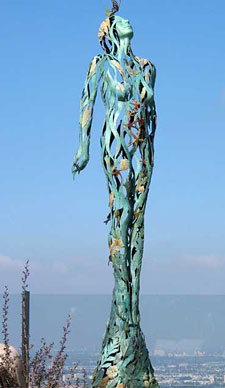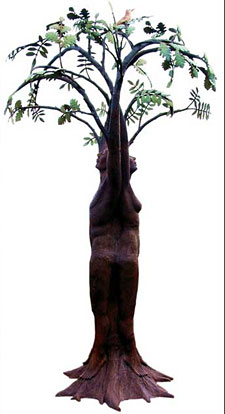Delicate Strength: The Filigree Work of Linda Brunker
 Earth, Water, Air bronze sculpture
Earth, Water, Air bronze sculpture Photograph courtesy of Linda Brunker
Linda Brunker possesses a deft touch with her bronze figurative sculptures. Although her pieces are solidly cast in bronze, her open filigree pieces feel light and delicate.
A native of Dublin, Ireland, she studied at the National College of Art & Design, and received a degree in Fine Art and Sculpture. After twenty years of success she has found renewed inspiration in the arts community of Ojai, north of Los Angeles.
"My family was very supportive growing up," says Brunker, who sold her first sculpture while still in college. Soon after, galleries in Ireland snapped up her work, in part because of their stunning visuals, and also because she was one of the few women casting bronze. Since then, her work has landed in private collections, and commissioned for public art and corporations in Ireland, England, Belgium and the throughout the U.S.
It is Brunker's gift for intertwining the human body and natural elements like plants and animals that shapes her work.
"Isn't it interesting that the pattern of veins on a leaf is so similar to the veins that carry blood to every cell in the human body?" she asks. Using the lost wax method, she painstakingly creates molds from leaves which she grows herself. These plants, grown to her specifications in terms of size and shape, take multiple molds to get the casting correct.
"The average thickness is about 1/4 inch," she says. "However, it varies with my filigree work. In order to get the molten bronze to flow throughout the entire casting I sometimes make some points thicker to facilitate this."
 Healing Tree bronze sculpture
Healing Tree bronze sculpture Photograph courtesy of Linda Brunker
The end result is a bronze sculpture which looks as light as air. "Bronze offers a greater flexibility and I can create fragile looking pieces which are actually very sturdy," she adds. "It can assume any shape, any size. That's my trademark, my style, this idea of fragile." It's certainly more work, for her and the foundry she uses, American Fine Arts Foundry in Burbank, California, but as she puts it, "I'm always pushing the boundaries of casting."
And that drive extends to her patinas.
"Chemical patinas or the natural patinas that bronze develops with oxidization can have great depth and a natural subtlety that is of the earth and nature and hard to achieve with other materials," she advises. And given that nature is a hallmark of her work, it's appropriate that the patina reflect the organic aging process.
Though she has more male collectors, she's notices that women identify with her work on a deeper, more emotional level.
"I find that people want to touch my bronze sculptures - it has a warm quality which encourages that," she says. "Copper is a natural conductor and does retain heat and energy which might explain why some bronze sculptures seem to emit an energy all of their own."
Resources:
Also in this Issue:
- Michael Worthington's Lucky Penny Art
- Fluid and Organic, Sculptor Gregory Leavitt's Work Sparks the Imagination
- Delicate Strength: The Filigree Work of Linda Brunker
- Foundry a la Femme
- Smithsonian's National Numismatic Collection Receives Sacagawea Donation
